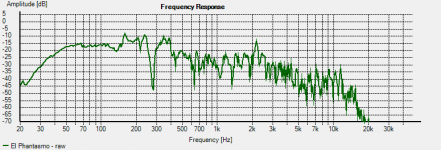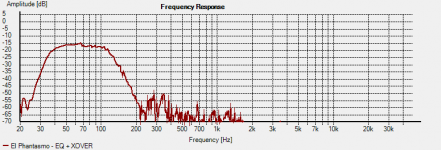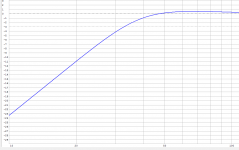Setup:
12" Ultimax in 2cf sealed box
Behringer NU3000DSP
I'm trying to squeeze as much performance out of this little thing as I can. I recall hearing that you should only use a parametric EQ to tame peaks by reducing frequencies, never to increase them. Is this true or is it more about amp headroom?
For example, my sub falls off a cliff around 36hz. Would it be dangerous for the driver to bump up the 25-30hz range by 3dB? I have amp to spare since I'm running it bridged to just the one sub.
12" Ultimax in 2cf sealed box
Behringer NU3000DSP
I'm trying to squeeze as much performance out of this little thing as I can. I recall hearing that you should only use a parametric EQ to tame peaks by reducing frequencies, never to increase them. Is this true or is it more about amp headroom?
For example, my sub falls off a cliff around 36hz. Would it be dangerous for the driver to bump up the 25-30hz range by 3dB? I have amp to spare since I'm running it bridged to just the one sub.
Last edited:
Hi,
Don't try to EQ out deep room dips with EQ. Bass end wise EQ away,
high power sealed subs have 6dB to 10dB of low bass boost built in.
A sealed box shouldn't fall off a cliff at any frequency, though
a lowest 36Hz room mode may make it appear it do so.
So EQ out the the 36Hz peak and add general bass boost.
rgds, sreten.
Don't try to EQ out deep room dips with EQ. Bass end wise EQ away,
high power sealed subs have 6dB to 10dB of low bass boost built in.
A sealed box shouldn't fall off a cliff at any frequency, though
a lowest 36Hz room mode may make it appear it do so.
So EQ out the the 36Hz peak and add general bass boost.
rgds, sreten.
Last edited:
The NU 3000DSP is a great little amp when it comes to DSP options, so yes, you should take advantage of them. The 8-band parametric EQ could be used to get a bit more low end out of your Ultimax-based subwoofer. Or, you could use the "Dynamic EQ" option to basically the same thing, but have it vary with output level so you don't end up over-driving your subwoofer at very low frequencies. For example, you could use the parametric EQ to extend the F3 down to 30 Hz, then the dynamic EQ to add some additional dynamic boost to get that down to the low 20's at lower output levels.
The attached files show the FR of my POC#3 TH (1) before and (2) after using the DSP options on my NU3000 DSP to clean the response up and extend it a little, and provide over-excursion protection at frequencies below Fb.
The attached files show the FR of my POC#3 TH (1) before and (2) after using the DSP options on my NU3000 DSP to clean the response up and extend it a little, and provide over-excursion protection at frequencies below Fb.
Attachments
I would bump it as much as 6dB. Those amps have great protection circuits so I think the worst thing that might happen is that you might bottom out your driver on some hotter content but I would guess that you'll be just fine on that too unless you turn up movies real loud.
Parametric EQ is IMO the best invention in audio. I EQ my mains with one and I use cut and boost to cheat my stuff to as flat as possible. When I go past plus or minus 6dB it starts sounding a little screwy. Use a band to pull down your peak and boost down low and you'll be styling. Try not to let the bandwidths of your filters cross into each other too much or it starts sounding weird.
Parametric EQ is IMO the best invention in audio. I EQ my mains with one and I use cut and boost to cheat my stuff to as flat as possible. When I go past plus or minus 6dB it starts sounding a little screwy. Use a band to pull down your peak and boost down low and you'll be styling. Try not to let the bandwidths of your filters cross into each other too much or it starts sounding weird.
Thank you very much the replies. This is very encouraging.
Would it be best to use fewer bands with lower Qs or more with higher? I've been doing the latter and the graph looks really peaky. I don't have measuring equipment; basically all I've used is an online tone generator and gauged by ear.
Would it be best to use fewer bands with lower Qs or more with higher? I've been doing the latter and the graph looks really peaky. I don't have measuring equipment; basically all I've used is an online tone generator and gauged by ear.
In general it's totally possible and beneficial to use PEQ to extend response provided you're not driving the sub at high levels.
If by "squeeze as much performance" out of it, you mean extending frequency response at low SPL, absolutely.
Just remember that a few dB of bump at the low end can easily add a lot of excursion and power consumption. At low volumes, this isn't a problem. If you're already running near the driver's excursion or power limits to get high SPL, it could be a bad idea.
A clever DEQ setup could do both. Extended LF response at low volume while keeping your driver safe at high volumes. The NU3000DSP can definitely do this.
If by "squeeze as much performance" out of it, you mean extending frequency response at low SPL, absolutely.
Just remember that a few dB of bump at the low end can easily add a lot of excursion and power consumption. At low volumes, this isn't a problem. If you're already running near the driver's excursion or power limits to get high SPL, it could be a bad idea.
A clever DEQ setup could do both. Extended LF response at low volume while keeping your driver safe at high volumes. The NU3000DSP can definitely do this.
You probably have one main sharpish peak somewhere that you need to take down. Then the band lower than that can be more broad as long as like I said before, you don't overlap the two very much.
I have done it by ear but it's like trying to shoot a coke can off a fence with a rubber band at night. You have a decent sub rig... Get Room EQ Wizard for free and at least a $50 measurement mic and maximize what you can do with your gear.
I have done it by ear but it's like trying to shoot a coke can off a fence with a rubber band at night. You have a decent sub rig... Get Room EQ Wizard for free and at least a $50 measurement mic and maximize what you can do with your gear.
Thank you very much the replies. This is very encouraging.
Would it be best to use fewer bands with lower Qs or more with higher? I've been doing the latter and the graph looks really peaky. I don't have measuring equipment; basically all I've used is an online tone generator and gauged by ear.
To use the EQ effectively, it is best to get your hands on a decent means of performing measurements. The REW software is free. So is HolmImpulse. All you need to do is to obtain a mic to make the measurements. Even a cheap RS SPL meter could work (though you'll have to adjust for the C-weighting).
Concerning correcting the response, I'm in favour of using PEQ to correct the raw response of the subwoofer. I'm less in favour of using PEQ to correct the in-room response, because in doing so you usually end up making it sound better in some locations and worse in others. It may be better to play around with the physical location of the subwoofer or use some other means to address the in-room aberrations.
In my HT setup, my sub is located right behind the sofa, my usual listening position. The near-field response of the subwoofer basically swamps any aberrations caused by the room. And I don't have to deploy multiple big subs to get audible response down to 20 Hz either... 🙂.
You probably have one main sharpish peak somewhere that you need to take down.
In this room, that's 40-47hz. When the tone sweep hit that range, the volume tripled at the listening position. Even EQd at -15dB it's still louder than the rest of the spectrum.
Assuming all else is equal, would you or anyone else have a suggestion for settings? I really am new at this, especially the dynamic EQ, though I am trying to learn which is why I went with DIY and the pro amp.
I would need to know how your amp does the bandwidth setting for the filter. I have a behringer parametric and they do it with a fraction. Like x/60. Is your amp like that too? It would also help to have a close mic of your speaker. Someone has probably posted it online somewhere.
I can guess one for ya just keep in mind it can easily make things worse because I have no idea what your room is doing to your response.
I can guess one for ya just keep in mind it can easily make things worse because I have no idea what your room is doing to your response.
I would need to know how your amp does the bandwidth setting for the filter. I have a behringer parametric and they do it with a fraction. Like x/60. Is your amp like that too? It would also help to have a close mic of your speaker. Someone has probably posted it online somewhere.
I can guess one for ya just keep in mind it can easily make things worse because I have no idea what your room is doing to your response.
Any help would be appreciated. If it sounds worse I can just restore the old settings.
I played around with it a little and removed all the overlap. Right now I have +6dB at 25hz with a Q of 2.4 and -6 at 47hz with a Q of 5.5. It sounds flatter than before but still feels like it's missing impact. Not that I expect the world from a small sealed sub, but I know it should do better than it is currently.
I don't know what you mean with the fraction. My only PEQ options are Gain (-15dB to +15), Frequency and Quality (0.10 to 10.0 in 0.01 increments.)
Thanks again.
Last edited:
I should also mention, in case it makes a difference, that the sub is in the optimal position in the room after weeks of moving it around and the room itself is quite small - 14L x 10W x 9H ft. I was told room gain should be amazing below 30hz, but I'm not hearing or feeling it.
It's also not an issue with input signal. I used to use an Aphex signal converter/bump box between my old receiver and amp, but I've since upgraded to a receiver with adequate pre-out voltage. I tried the Aphex with it and at minimum gain on the box it clipped the amp, so I know that's not an issue going straight from the receiver to the amp using a RCA-XLR cable.
It's also not an issue with input signal. I used to use an Aphex signal converter/bump box between my old receiver and amp, but I've since upgraded to a receiver with adequate pre-out voltage. I tried the Aphex with it and at minimum gain on the box it clipped the amp, so I know that's not an issue going straight from the receiver to the amp using a RCA-XLR cable.
Last edited:
I really should grab an Omni mic while they're on sale at PE. Judging by ear is difficult as I don't know how far it's fallen after the huge 40-47hz spike. 80-60 is a gradual upward slope, dips a little in the 50s, shoots like crazy in the 40s, then back down around 39 as it climbs up again to 36, then it's straight down from there.
It's ridiculous trying to do this over a forum with no measurements, isn't it?
It's ridiculous trying to do this over a forum with no measurements, isn't it?
Not ridiculous, you have to start somewhere. I'll post more tomorrow. I just helped a buddy of mine flatten out his system and after I flattened out his close mic response, the room took it and really made it sound terrible. So in that case, a mic was the only thing saving us. Every time is a little bit different.
You'll probably end up getting into it sooner or later seeing as you have an interest and a PEQ though. How does that amp do with your twelve, by the way? Will it bottom it out if you push it or does your driver starve for more?
You'll probably end up getting into it sooner or later seeing as you have an interest and a PEQ though. How does that amp do with your twelve, by the way? Will it bottom it out if you push it or does your driver starve for more?
The red clip lights come on before the driver bottoms out. That's without the limiter, so I assume it's getting a bit over 1200 watts if the amp measurements I've seen are accurate.
- Status
- Not open for further replies.
- Home
- Loudspeakers
- Subwoofers
- Boosting subwoofer frequencies with PEQ bad?


